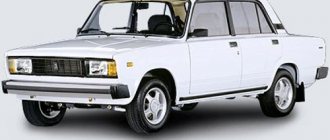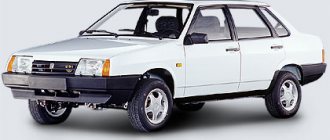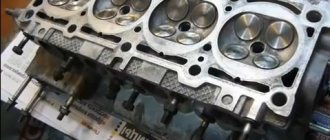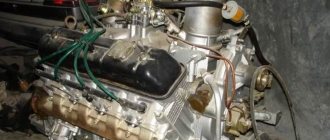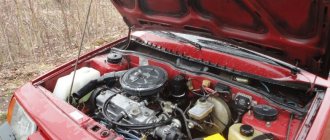The VAZ-1111 Oka model was originally designed as an affordable budget car for novice drivers and people with disabilities. The main task of the designers was to produce a vehicle that the owner could service independently, that is, without going to a service station. For this reason, the power unit and other components were made from mass-produced and fully accessible components.
In this article we intend to talk about what kind of internal combustion engines were installed on the VAZ-1111, what are the features of power plants for this model, and also what can be used to replace the standard Oka engine if such modifications to the car are necessary.
How to increase car engine power oka
Boosting internal combustion engines
In this article we will cover the topic of fine-tuning the cylinder head, thanks to which we can fully count on some increase in engine power.
Finishing the cylinder head (cylinder head) and manifolds The essence of the work is to make it as easy as possible to inject a fresh fuel-air mixture into the working volume, thereby increasing the filling of the cylinders, and therefore the power with torque.
SADDLES AND CHAMBERS
The saddles will have to be chamfered.
This is done with special countersinks and three repair chamfers are usually removed on each saddle: 30, 45 and 60 degrees. The sequence of actions can be almost any. Those. You can first remove 30 and 60 chamfers, and then 45. You can, on the contrary, first remove 45, and then bring it to the required size using 20 and 60 chamfers. I usually first remove the internal chamfer (60), then the external one (30), and only then very carefully remove the 45 working chamfer.
And if I need to correct it, I do it using an external chamfer (30 degrees). It is recommended to leave the working chamfer (45°) at a width of about 1.5 mm on the intake valve, and about 1.8 mm on the exhaust valve. But this time I made about 1.2mm on the inlet and about 1.5mm on the outlet. As experience has shown: valves and chamfers tend to click over 2-4 thousand km after repair and gradually grind in, thermal clearances change, and chamfer width changes. Therefore, when I removed a 1.5 mm chamfer, after 5 thousand I found a 1.8 mm chamfer there. Well, maybe this is a purely subjective perception? Next, we dry all the valves back and install the pushers. Naturally, we lubricate this whole thing with motor oil along the way? And bushings, and valve stems, and valve stem seals? In a word, everything that slides. This is discussed in detail in the Murzilkas.
I would also recommend going over the carburetor chambers with P2000 sandpaper and mirroring the walls there. The fact is that no matter how many cars I look at, even new ones, they all have BLACK tarred first carb chambers. This looks kind of wild, and probably disrupts the mixture formation. Experience has shown that if these chamber walls are sanded with P1000-2000 sandpaper (so fine, just like paper!), then the chambers always remain clean, regardless of mileage. Having done the grinding once, I no longer suffered from getting the camera dirty. (See photo)
Good luck, friends. It's a painstaking task, but it's worth it.
Source
Service
This section includes not only changing the oil, but also adjusting the clearances in the valve mechanism.
The first step is to talk about the simplest thing, changing the engine oil. To do this you will need the following tools:
- key to 17;
- small container for waste liquid;
- new oil;
- screwdriver.
Before starting work, you need to turn off the car engine and install supports for the wheels. This is necessary for safety, so that no surprises happen during work.
Change of oil
If you want to completely change the oil type (if the oil type remains the same, then the following steps are not necessary):
- first flush the entire system with flushing oil;
- To do this, you need to pour in a little liquid to the lower mark and start the engine from the Oka. Experts recommend letting it run for 10 minutes. During this time, a special liquid will pass several times throughout the entire system and collect all the slag.
- After this, you can drain it and replace the oil filter. This is necessary to ensure that the new oil does not receive unknown substances while passing through the filter.
- Engine oil should be filled to the top mark, to the maximum. Next, wait about 10 minutes and add engine fluid if necessary.
LIST OF WORKS:
- Turn the filler cap and remove it;
- Remove the drain plug under the car engine. This is necessary so that the old oil is drained into a special container;
- Screw the plug back;
- It is worth remembering that the oil is very hot during draining. Next, you can unscrew the oil filter and put it aside. It won't be needed anymore;
- To unscrew the filter, it is better to use a special wrench;
- Fill the filter cavity with new oil to the middle;
- Do not forget about lubricating the o-ring, which is located on the filter;
- Fill the filler neck with new engine oil to the maximum and screw on the cap;
- We start the engine and let it run for a few seconds. During this time, you can check for leaks and oil level. If necessary, it can be increased.
Gap adjustment
To compensate for the expansion of parts during operation, the designers provided a special gap between the valve stem and the cam itself. If the gap increases, the valves may not open, and if the gap decreases, they may not close. This needs to be monitored almost every day.
You only need to check the gap on a cold engine when all parts are in standard condition. The minimum clearance of the intake valve should be 0.2 millimeters, and the exhaust valve 0.35 millimeters. If this is not observed, the Eye's engine will operate unstably, with some noise and whistling.
The valves must be counted from the camshaft belt: the 1st and 4th valves are exhaust, and the 2nd and 3rd are intake. It is worth noting that the order of adjustment is not important. That is, adjustments can be made in any order.
For this job you will need a 10mm wrench, a set of screwdrivers, feeler gauges and tools for adjusting the gaps. If you cannot turn the crankshaft, you can use the following advice. Engage fourth gear and drive the vehicle very slowly until the cam is in position.
LIST OF WORKS:
- Remove the air filter;
- Cover the carburetor with a special rag so that nothing gets in there;
- Unscrew the cylinder head cover;
- Turn the crankshaft several times using a special wrench. To simplify this action, you can engage the gear and remove the spark plugs;
- The marks on the alternator pulley and the front cover must match. If this does not happen, then you have not fully rotated the wheel. During this step, you can begin adjusting the car valves. It is worth paying attention to the fact that there are two marks on the cover. You only need to focus on the long mark;
- Next, measure the thermal gap using a flat feeler gauge. These values can be written down in a notebook and compared with the nominal values in a special manual;
- Attach a special device to the lid;
- Put on the washers and turn them;
- Press the lever and push the pusher down. Insert the clamp under the camshaft so that the protrusion fixes the pusher;
- Next, you can pry the adjusting washer and remove it. Record the thickness of the washer;
- We calculate the thickness of the new washer using the formula: H = B + A - C, where H is the thickness of the new washer; B - thickness of the old washer; A is the value of the measured gap; C—nominal clearance;
- We install it in the pusher and perform the actions in the reverse order;
- Rotate the crankshaft 360 degrees and adjust the thermal gap;
- We install the parts in the reverse order so that the Oka engine is in the same condition.
Engine of the Eye
The Oka was created as a people's car, designed to satisfy the demand not only of young people, but also to fill the existing niche of transport and mobility vehicles for people with disabilities.
Based on the technical requirements and the assignment put forward to the designers, the entire car, and in particular the power unit, had to be made from widely used components and be able to carry out maintenance and repairs with one’s own hands without involving the qualified services of a certified service station.
The history of the development of the Oka family of cars has seen the use of various power units. Initially, during “prototyping” the original Daihatsu Cuore AB series engine was installed on the car, which had 2 cylinders and developed a power of 26-30 hp. The first few vehicles were produced for testing.
Despite the fact that the engine design was completely worked out by Toyota designers, this engine was not copied by Soviet designers, since the analysis of the design revealed increased requirements for the quality of parts and assembly of the engine itself.
In addition, the installation of such a power unit would require a complete production of engines from “0”, which would affect the final cost of the car and the timing of the car’s production.
By the time the concept of a “youth” or “people’s” car was approved, a VAZ 2108 car was delivered to the assembly line of the Togliatti automobile plant, which determined the fate of the power unit for the baby.
By 1979, VAZ power unit designers had fully developed the 2108 engine and were ready to move on to changing the line of 1.1 liter export VAZ 2108-1 engines to the 1300 cc 2108 engine, which was going to the domestic market. Therefore, it was decided to develop its own 2-cylinder engine based on a new power unit, which formed the basis of VAZ’s production line.
The structure of the carburetor Oka... Device repair
| Fuel level - OKA - forums on The carburetor, which is installed on an OKA car, is designed to solve the same problems as similar devices that are used on other models of passenger cars. But the very bottom of our carb has common dimensions with Ozone, and is completely connected to it along all the channels and tubes; the cross-sections of the throttle holes are the same, and the fuel is supplied through 2 tubes, located in the same place where we have some differences in the lever systems, but they are all solved by a combination of these systems. |
| Adjusting the DaAZ Oka carburetor - Automotive portal AutoMotoGid It is often possible to achieve fuel economy and more stable engine operation by repairing the carburetor, replacing the repair kit, and making proper adjustments. Parameters Chamber first second Diffuser diameter, mm 20 25 Mixing chamber diameter, mm 28 36 Calibration of the main fuel jet 95 95 102.5 Calibration of the main air jet 170 85 Calibration of the fuel jet of the idle jet and the diameter of the transition system of the second chamber 41 0.50 Air diameter idle jets and transition system of the second chamber, mm 1.5 0.7 Diameter of the econostat fuel jet, mm 0.95 Diameter of the accelerator pump nozzles, mm 0.40 0.35 Fuel supply by the accelerator pump, cm3 per 10 strokes 8.0 2 .0 Starting clearances of dampers, mm air throttle 2.2 0.2 0.7 0.8. |
Cleaning the VAZ Oka carburetor with your own hands • during the work process, it is advisable to turn on all energy consumers on the Oka, lighting devices, fan, acoustic system, etc.
Engine VAZ 1111
Oka engine 650 cc. turned out from half of the 2108 power unit. The choice of exactly half of the already developed block and the engine itself was determined by the cost of developing equipment for the manufacture of a 2-cylinder engine. A design feature of this in-line petrol twin is the overhead camshaft, which controls the operation of four valves - 2 for each cylinder.
The working process in the engine occurs in two revolutions of the crankshaft, which causes vibrations during operation of the internal combustion engine. To compensate for the imbalance, two balancing shafts are installed to dampen vibration. Engine power is 29 hp. The maximum torque is 44.1 Nm, which is achieved at 3400 rpm.
The fuel supply system is made according to the Euro-0 standard based on a carburetor. The fuel pump is mechanically driven by engine components.
The oil system is similar to the original 2108 using a gear pump. Oil is taken from the crankcase and sent through internal channels directly to the rubbing pairs of the camshaft and crankshaft.
The cylinder walls are lubricated by oil mist generated when the crankshaft rotates. The valve stems and parts of the valve timing mechanism, with the exception of the camshaft itself, are lubricated by gravity.
Engine VAZ 11113
The Oka 11113 (VAZ 11113) engine appeared in the process of refining the VAZ 2108 power unit and bringing its working volume to 1500 hp. Again, a half solution was used. The engine blocks of both 650 and 750 cc volumes were absolutely identical in appearance. The changes affected the piston diameter, which was increased from 76 to 81 mm. The engine block has been modified in internal design.
The partitions between the cylinders were thinned and the additional combustion chamber cooling circuit was eliminated. The power unit has become more highly loaded in the temperature department. This shortcoming in the early stages led to jamming of the pistons, the formation of scuffing on the cylinder walls and other malfunctions arising due to insufficient cooling.
Due to the modifications, the 11113 engine became more powerful and already produced 35 hp. and 52 Nm of thrust. The engine remained carburetor and complied with Euro-0 environmental requirements.
Basic faults
The main malfunctions of the first 650 cc engines and engine 11113 include increased noise and vibration. Increased noise appears when the engine warms up and is caused by the presence of balancer shafts. The noise is considered normal, although it causes concern for car owners.
Burnt out cylinder head gasket. It is caused by inaccurate manufacturing of gaskets in factories and improper tightening of the cylinder head, which allows the gasket to be incompletely compressed. During repairs, reuse of this sealing element is not allowed. Mandatory replacement is required, in this case you should pay attention to the surface of the gasket and if scuffing is detected, you should not use it.
Difficulties in starting a hot 750 cm 3 engine are due to the fuel pump diaphragm and the layout of the engine compartment. Elevated operating temperatures of the engine block lead to the formation of fuel vapors in the cavities of the pump, and the unit is not intended for pumping a gaseous medium.
If a malfunction occurs on the highway, just place a dampened rag on the pump body. This will be enough to get to the base location and replace the diaphragm.
Loss of spark. The spark generation system in the cylinders is made according to a non-contact circuit using an ignition coil. The location of the coil allows water to enter when passing through puddles. This causes failure of the voltage boosting element and results in the inability to start the engine.
Cooling system. It has the same problems as all VAZ engines. Poor quality of the pump leads to its failure, which in due course leads to overheating of the engine. The same applies to the reliability of the thermostat. If problems arise, elements need to be replaced.
Failures of electronic sensors. They are caused by poor-quality electronics by Russian manufacturers, as well as poor assembly standards of power units, which allow for incomplete fixation of sensors on the motor housing.
Repair of the OKA engine can be performed in a garage if you have experience in servicing and repairing Russian-made internal combustion engines. With the exception of specific elements, engine repairs are carried out using components used for repairing VAZ 21083 and VAZ 21093 engines.
Cleaning the float chamber from carbon deposits • Installing the carburetor on the eye
| What is the real consumption of Oka gasoline with 750 cm3? ( - OKA - forums on The price of this unit is relatively small, and many can afford such an installation, but some additional parts and minor modifications will be required. KU carburetor units of various modifications, repair kits, jets, gaskets and other parts are also sold for Okushka, they can be buy in specialized stores, and adjustment and repair of the fuel system is carried out not only by specialists, but also by many car owners themselves. |
- idle speed disappears altogether;
- the engine behaves unstably at low speeds;
- The engine stops spontaneously and stalls.
Maintenance of Oka engines
The Oka engine of both the first and second generations is quite reliable. And if the factory requirements for maintenance regulations are met, it has a service life of 120,000 km.
According to the vehicle passport, both engine 11113 and engine 1111 have a maintenance program every 15,000 km. To undergo maintenance at this interval, it is recommended to use fully synthetic motor oil. When using semi-synthetics, and even more so mineral motor oils, the Oka engine requires changing the lubricant in accordance with the service life of the oil, that is, at least 10,000 km.
In this case, the oil system must be flushed and the filter element replaced. The oil volume in the Oka engine is 2.5 liters, but when replaced, 150-300 ml of lubricant remains on the engine walls, so the filling volume is controlled by the dipstick. Overfilling of oil is not allowed.
The OKA 11113 engine cooling system requires fluid replacement after operating 60,000 km. At the same time, the coolant retains its lubricating and anti-corrosion properties and prolongs the operation of the cooling system.
Every 30,000 km, mandatory valve adjustment is required. But in fact, the gaps are adjusted according to the technical condition with control at a given mileage.
Additional work that is not relevant on modern cars includes mandatory cleaning of the carburetor every 30,000 km with idle adjustment at each regular maintenance.
At 60,000 km, regardless of the technical condition, the timing belt is replaced. The design of the cylinder-piston group allows the valves to bend when the belt breaks, so this procedure should not be neglected.
Installing a carburetor on the Oka
So it turns out that in summer the consumption is 5.5 liters, and in winter apparently 6.5 liters, which is not so little and becomes comparable to a carburetor-tuned chisel. Parameters Chamber first second Diffuser diameter, mm 20 25 Mixing chamber diameter, mm 28 36 Calibration of the main fuel jet 95 95 102.5 Calibration of the main air jet 170 85 Calibration of the fuel jet of the idle jet and the diameter of the transition system of the second chamber 41 0.50 Air diameter idle jets and transition system of the second chamber, mm 1.5 0.7 Diameter of the econostat fuel jet, mm 0.95 Diameter of the accelerator pump nozzles, mm 0.40 0.35 Fuel supply by the accelerator pump, cm3 per 10 strokes 8.0 2 .0 Starting clearances of dampers, mm air throttle 2.2 0.2 0.7 0.8.
Tuning and modification of Oka engines
Tuning the Oka engine does not make practical sense under normal operating conditions. Increasing power and torque when flashing ECM units can give an increase of up to 10% horsepower, which is about 30 hp. will not be particularly practical.
As a garage modification, Oka engine tuning is performed by installing an injector from a VAZ 21083i, but the cost of modification can be comparable to installing a Chinese liter TJ376QE FAW engine (Daihatsu), which was mounted on a Serpukhov-made SeAZ Oka 11116-02 car in 2007-08.
Suspension tuning
When converting an Oka into an SUV, improving driving characteristics is the car owner’s primary task, since the standard suspension leaves much to be desired. For this purpose, gas-oil shock absorbers are installed, increasing the vehicle's handling and stability.
It is not worth changing the standard springs, since improved modifications quickly fail. When converting an Oka, 13-wheelers are fitted with tires of the appropriate size.
To create an SUV, the suspension is lifted using a special set or installing spacers under the springs. As a result, the rear of the car rises, but the shock absorber mounts require modification.
Other small-scale Oka power units
Only VAZ 1111 and VAZ 11113 engines were serially installed on the car. It was with these power units that the car was supplied to retail chains.
As options to save production and meet environmental requirements, both SeAZ and KAMAZ tried to use power units from other manufacturers. This was due to the fact that AvtoVAZ refused to continue producing minicars and actually stopped supplying power units to complete the car.
So in 2004, a trial series of cars with a Korean Hyundai Atos engine was produced. 15 cars were produced for trial testing, but the program did not go into series.
Also this year, small-scale tests were carried out at SeAZ of cars with engines from the Melitopol plant MeMZ 245. The car was called OKA-Astro and was subsequently produced in small series at the Kamov automobile assembly plant. Another version of the Ukrainian power unit was MeMZ 247.1. This engine, which complied with Euro-2 requirements, was not supplied for mass production, although such equipment is rarely found on the secondary market.
In 2007-2008, a Chinese three-cylinder injection engine was installed at the Serpukhov plant, which developed 53 hp.
The sports version of the Oka uses the engine from Priora.
The Oka-based tracked all-terrain vehicle uses a VAZ 2131 engine.
As an option for garage tuning, there are several examples of cars using three-cylinder Volkswagen diesel engines.
Source
What kind of engine can be installed for the Oka?
The VAZ-1111 Oka model was originally designed as an affordable budget car for novice drivers and people with disabilities. The main task of the designers was to produce a vehicle that the owner could service independently, that is, without going to a service station. For this reason, the power unit and other components were made from mass-produced and fully accessible components.
In this article we intend to talk about what kind of internal combustion engines were installed on the VAZ-1111, what are the features of power plants for this model, and also what can be used to replace the standard Oka engine if such modifications to the car are necessary.
Increased comfort
A seat for a mini-tractor with increased comfort.
Homemade mini-tractors based on this Oka car are usually assembled without springs. As a result, the driver strongly feels all the shocks while driving. In the case of prolonged use of such equipment, vibrations negatively affect the condition of the spine. To alleviate such harmful effects, it is worth installing soft springs under the seat.
If you have to use the car at night, then you need to address the issue of creating electrical wiring and headlights. In most cases, such elements are not required.
Video: Homemade mini tractor with OKA engine
Publications on the topic
Making a homemade caterpillar mini tractor
Algorithm for assembling a homemade 4x4 mini-tractor
Self-production of a mini-tractor from a walk-behind tractor
Engines of VAZ "Oka"
Let us immediately note that the Eye model received different power plants at different times. At the development stage, they planned to equip the car with a Japanese engine, which was intended for Daihatsu subcompacts. This power unit is 2-cylinder, power is about 30 hp. A little later, the first pre-production versions of the Oka, designed for testing and trials, appeared with such an engine.
Also, the car plant did not seek to launch production of a completely new engine, which would inevitably affect the final price of the Oka and delay the start of serial production of the car. The result is that the Japanese engine never made it under the hood of the compact.
The specified Oka engine has a displacement of 650 “cubes” and is actually half of the VAZ 2108 engine. This approach allowed us to avoid the costs of developing a new block and timing belt for a small-volume engine. So, the engine is in-line, gasoline, two-cylinder, with an overhead camshaft and 2 valves per cylinder.
It is noteworthy that the working process is implemented in 2 crankshaft revolutions, that is, such an engine is quite heavily vibration-loaded. To compensate for this drawback, as many as 2 balancing shafts were introduced into the design to reduce vibrations.
The power of such a unit is almost 30 hp, the torque characteristic is 44.1 Nm at 3400 rpm. Carburetor engine, mechanically driven fuel pump.
It is noteworthy that this engine, although it has become more modern and powerful, produces 35 hp. and 52 Newtons of torque, it also had cooling problems. After the appearance of the first versions, the pistons could jam from overheating, scuff marks appeared on the cylinder walls, etc.
Main malfunctions of VAZ Oka engines
As for the frequent problems of both the first and second versions (650 and 750 “cubes”), vibration and noise levels should be highlighted. In this case, noise is normal, especially on a cold engine when warming up. The valve mechanism is also noisy, especially if the thermal clearances of the valves are not adjusted.
Let's move on. On such engines, the cylinder head gasket often burns out. The problem is both in the quality of the gaskets themselves and in the incorrect tightening of the head during engine repair. There is also a problem with starting a hot 750 cc internal combustion engine, which is directly related to the fuel pump diaphragm and the layout of the engine compartment.
It is also noted on these engines that the ignition spark disappears. The reason is a contactless circuit with an ignition coil, and the coil is positioned in such a way that when driving through puddles, water can get in there.
As for the cooling system, the pump often fails and the engine overheats. The thermostat is also not very reliable. Failures of temperature and other sensors are also possible due to their poor quality and poor assembly, when the sensors are not securely attached to the engine.
Oka engine tuning and swap
There is a group of car enthusiasts for whom the Oka model, due to a number of features, is of particular interest in terms of tuning. Since this car is small and light, and has a weak engine, it is not surprising that increasing the power of such a motor becomes the number one issue.
It is not difficult to guess that a much more effective solution in this case would be a swap, that is, a complete replacement of the internal combustion engine, rather than an attempt to increase the power of the existing factory version. To understand which engine can be installed on the Oka, you need to analyze information about those units that were installed on this model, but for one reason or another were never included in the series.
When auto production in Russia was going through a crisis and AvtoVAZ refused to produce engines for the Oka, in order to maintain production and comply with environmental requirements, attempts were made to install units from other manufacturers on this model. In 2004, a trial batch of 15 cars with an engine from Hyundai Atos was produced; the Ukrainian MeMZ 245 and MeMZ 247.1 engines were also installed on the model.
As a summary, we note that, as in the case of the diesel Niva, the Oka car can also be equipped with a different engine if desired. The easiest way would be to install a motor that the manufacturer himself has already installed on this model as a trial version.
If we talk about a real swap and the installation of an internal combustion engine that has never been installed on this model, in practice compact 3-cylinder Volkswagen diesel engines are well suited to Oka. Even in single copies, tuners installed MeMZ 245 or MeMZ 247.1, after which this engine received additional turbocharging.
Installing a diesel engine on a Niva SUV instead of a gasoline one. What you need to know when replacing the original Niva engine, suitable diesel engines and gearboxes.
Advantages of installing a diesel power unit instead of gasoline or LPG. Choosing a suitable diesel engine for GAZelle and UAZ (UAZ) to replace a gasoline engine.
The range of engines for the Lada X-Ray, available power units. Features and performance indicators of engines on Lada Xray, innovation, reliability.
Restyled Volkswagen Polo sedan with a new engine. The main features of the new Russian-assembled engine CFN E211 on the Polo Sedan from Kaluga.
Lada Vesta: what oil is best to fill in the engine of this car and how to choose the right lubricant. Recommendations, useful tips.
Tuning the Lada Vesta engine, affordable ways to increase power and improve the characteristics of the Vesta power unit. Chip tuning Lada Vesta, what you need to know.
Source
Oka car tuning: examples of car improvements
Oka VAZ 11113 is a small Russian hatchback, production of which began in 1988 and ended quite recently, in 2008. The car was initially produced at the Volga AvtoVAZ plant, after which production was transferred to the SeAZ and ZMA plant.
The very first Oka was the cheapest Russian car, which included an engine with 29 “horses” of power and a volume of 0.6 liters.
After which an improved version of the Oka 11113 appeared, with a two-cylinder engine with a volume of 0.7 liters and a power of 33 horsepower. The car came with a 4-speed gearbox. But you can make something worthwhile out of such a car if you do OKA tuning.
The maximum speed that the car can reach is 140 km/h. Then the car was modernized by a Chinese concern, with a 1-liter engine and a power of 53 horsepower, the car brand began to be called Seaz11116, the equipment was equipped with a 5-speed manual.
The maximum speed that the car could reach was 150 km/h. The car has a spare wheel on the rear door, a guard, tubular sills, and looking at such attributes we can say that Oka’s car is a real compact SUV.
Design. Device repair
| Tuning the carburetor oka So it turns out that in summer the consumption is 5.5 liters, and in winter apparently 6.5 liters, which is not so little and becomes comparable to a carburetor tuned chisel. Self-repair of a carburetor device requires a clear identification of the malfunction, the ability to properly dismantle the mechanism and wash it. |
| Adjusting the Oka 11113 carburetor with my own hands. For example, I use the well-known method, first I use the quality screw to achieve maximum XX speed, then I use the quantity screw to set it to 1100 rpm, again I use the quality screw to achieve the maximum, again I slightly adjust the quantity screw to 1100 rpm, the repeated adjustment is associated with a feature of the system is XX carbs like quot; Solex quot;, carbs like quot; Ozone quot; They have a completely autonomous idle system, where the number of idle revolutions is regulated not by opening the throttle, but by the amount of mixture of the idle system; after that, depleting the mixture with a quality screw, I set it to 1000 rpm. However, if the car owner has experience in independently servicing his car, then it is allowed to clean the carburetor from carbon deposits with his own hands. |
Adjusting the gasoline level Oka 11113 • Inspect the float and its mounting parts.
OKA tuning: refinement of appearance
The OKA jeep-all-terrain vehicle is designed for off-road driving. The car borrowed many parts to increase its cross-country ability; the car body, lighting equipment, seat and upholstery remained from the original parts.
The front panel is borrowed from the eight, and the armrest and stove from the five. Kengurin from the Ssang Young Musso model, which is very necessary for off-road use. The car demonstrates ease of movement, maneuverability on the road and good maneuverability.
Under the hood of the car there is an injector and an engine from the well-known company Rover Mini, with a volume of 1.3 liters and a power of 63 horsepower. To show the capabilities of the machine, you cannot stand still and discuss details. You need to get a feel for the car and start moving.
The driving performance of the Oka model is well demonstrated by the 14-inch wheels, which added significant weight to the car, thereby making the car even more like a jeep. To increase the vehicle's cross-country ability, the chassis and suspension were borrowed from the front-wheel drive VAZ.
Next is a video about OKA Lambo tuning:
Dashboard tuning
Remaking the Oka dashboard is accompanied by difficulties associated with the compact dimensions of the car. Accordingly, it will not be possible to install a dashboard from other models, so all that remains is to remake the original panel.
Most often, car owners resort to covering the dashboard with film or leather. Using materials and tools, you can change the design of the panel and supplement it with connectors for special equipment.
Tuning the dashboard is done in two ways:
- Modernization of the standard panel.
- Replacing the dashboard with a new one.
The first option involves installing LED backlight lamps instead of conventional ones, a new substrate, or modifying the old one, which allows you to change the design of the panel. A complete replacement of the tidy will also require changes to the overall design.
When working on tuning the Oka dashboard, high-quality sealing must be taken into account: parts should not creak while driving.
Stylish wheels and other chassis modifications
Many car enthusiasts like to drive on splayed wheels, so the VAZ 11113 Oka tuning widens the car's track by 150 mm and enlarges the arches to accommodate larger diameter wheels. You can install plastic covers on top of the arches, which will decorate the appearance of the car and create individuality.
Tuning the Eye can be done ad infinitum; it all depends, as a rule, on the owner’s imagination. External tuning of the Eye is considered one of the most important and noticeable elements of car modernization. It has become fashionable to do tuning of aerodynamic body kits, which can also change the appearance of the car and improve its technical characteristics.
If you lift the car body a little, you will immediately feel the gaze of passing envious people. Install good bumpers in place of the plastic ones, extend them and decorate them with linings, so you will noticeably expand the body of the car, and the Oka itself will look even more powerful.
Install a figure-eight steering shaft with a modified driver's position, so you will get the long-awaited comfort. And here are the long-awaited Oka tuning photos, with the listed upgrades.
Bumper tuning
The original Oka bumpers are almost impossible to modernize, since their tuning resource is limited due to the minimum surface area and the close proximity of the fog lights to each other. However, standard bumpers can be changed using a sanding tool, mounting foam and epoxy resin. When converting an Oka, car owners most often increase the lower part of the bumper by installing diffusers. However, such tuning technology is too labor-intensive and impractical.
The main difficulties that car enthusiasts face when upgrading a standard bumper are the formation of clear lines and a symmetrical surface. Car owners also encounter difficulties when developing a design, so, as a rule, a sample of a bumper from a sports car is taken as a basis.
The best option for upgrading the Oka bumper is to replace original parts with various modifications. Tuning of this kind is carried out quickly and simply; difficulties accompany only the installation of the rear bumper due to the presence of a tow bar. You can visually increase the dimensions of the body by using voluminous bumpers or moving them forward.
Remodeling Oka's salon according to Feng Shui
The first impression of the interior may seem sparse and insufficient for such a powerful car. Tuning the Oka's interior includes interior firmware, modern upholstery with high-quality material, installation of electric glass lifts and high-quality vibration and noise insulation. Head units, midbass, amplifiers and subwoofer are being updated.
The dashboard is also equipped with sound insulation, and electric lifts can move the windows at the touch of a button. The pedals have aluminum pads, which are often found in sports cars. A loud rectangular muffler will highlight the spirit of sport.
The car has a low degree of passive safety, so this feature needs to be urgently corrected. For the safety of passengers and the driver, install a safety panel and additional airbags. Plus, you can install disc brakes and a dynamic stabilization system.
Sometimes, as an Oka tuning, car enthusiasts purchase starting chargers. Such devices are necessary on the road when the battery runs out randomly. Additionally, you can decorate your car with interesting multi-color airbrushing and vinyl decoration.
Here, give free rein to a professional artist, and he will create a “car” that will surprise and stun everyone on the road. The most popular paintings on the body are in the fantasy style, dark castles, uncharted planets, stars, or the sky.
The main defects that occur during carburetor operation
We take a caliper or a specially cut piece of a ruler, measure the distance from the upper edge of the body to the surface of the gasoline, it should be within 22-23 mm;. Each of the systems in this unit performs its own specific task, and configuration and adjustment are carried out using adjusting screws, selection of jets, setting the angles of the throttle and air damper.
Adding traction to an Oka car
Many people think that if the car is small, there is no point in tuning the Oka for a jeep. It really consumes little gasoline, but all the factory parameters of the propulsion system were not ideally provided for, so some characteristics need to be modified.
To increase the power of the car, you need to tune the engine. Modernization begins with the replacement of all main components, namely the air filter, camshaft, carburetor and cylinder head.
The fuel exhaust and intake system will also have to be replaced; the cylinder engine will be changed to a Rover engine, which has a volume of 1.3 liters. With such an engine, the car accelerates evenly.
If a gas unit is installed in the car, it may also involve the installation of a camshaft with a lift level of 10.3 mm, and with a significantly increased compression ratio. When the engine of a gas unit is boosted, power increases accordingly and traction at the bottom improves.
Nowadays it is very popular to carry out engine chip tuning in cars, which significantly affects the increase in engine efficiency. This method of modernization differs from others in that the software in the motor control unit is changed.
The program can be adjusted taking into account the concealment of reserves and other characteristics. This method is considered the simplest and most powerful. If the car stops working, you can return the engine to factory specifications.
Chip tuning can reduce fuel consumption and reduce the emission of fuel into the atmosphere with harmful toxic substances. Chip tuning is now applicable to most Russian cars, including the famous VAZ 2106.
When tuning the Oka, it is necessary to replace the camshaft, pusher and grind the manifold. The grinding procedure means fitting the manifold channels to the head channels. Pushers of a special profile, with a lightweight valve and a new camshaft can significantly increase the power of the Oka engine.
For the new engine, it will be important to install a high-quality air filter, thereby allowing wheel speeds to reach 7000 rpm, and the aggressive notes of the engine will be noticeable on the road.
To reduce fuel loss at high speeds, the exhaust and intake channels are modified, the valve seats and the shape of the combustion chamber are changed. This type of tuning is considered one of the most expensive, since the master does all the work manually.
For a compact car, increased power will be a strong argument. By installing a main pair with a good gear ratio, you can increase the maximum speed of the Oka and also improve the acceleration characteristics, which even the driver himself can appreciate. The traction reserve will be felt while driving, it will add confidence and maneuverability on the road.
During the engine tuning process, you can get the following results:
Yactation at an early age
It is a rhythmic stereotypical swaying of the body or head back and forth or from side to side. Occurs mainly before falling asleep or after waking up. It occurs 2-3 times more often in boys than in girls.
The etiological factors leading to yactation are generally similar to those associated with finger sucking. Of particular importance in the origin of yactation is a chronic deficiency of external rhythmic stimulation (sensory deprivation) and limitation of motor activity. Children suffering from yactation often have an increased need for sensory stimulation from birth and, from the first months of life, show a special love for motion sickness, rhythm, and music. Psychotraumatic factors that provoke the occurrence of yactation should include, first of all, the separation of a child from his mother and, as a consequence, his upbringing in closed children's institutions (orphanages). Conflict relationships between family or team members, emotional and physical overload play an equally important role. The first manifestations of yactation may occur in connection with a change in the child’s life pattern (the appearance of teeth, the transition from sitting to crawling, from crawling to walking). In some cases, yactation is accompanied by sleep disturbances, which is confirmed by EEG studies. There is a connection between rocking episodes and transitional phases between paradoxical and synchronized sleep.
Yactation, along with finger sucking, most often occurs in early childhood. Already in the first year of life, all its clinical manifestations can be observed in a detailed form. Typical yactation involves rocking the head or body in an anteroposterior or lateral direction while sitting or standing. When rocking in a standing position, the child always holds on to the walls of the crib or playpen with his hands.
It should be noted that the position of the body in which yactation occurs is largely determined by the level of development of its motor skills. So, the baby is 4-5 months old. Having learned to roll over, rocking will manifest itself in the form of repeated rhythmic rolling from back to stomach and back. In this case, the child most often does not completely turn over onto his stomach, but is limited to only a lateral position. The described movements differ significantly from those that a baby normally produces when rolling on the horizontal surface of a changing table or playpen.
In the first half of the year, there is also a special form of yactation - rocking the body with support on the head and heels (the “wrestling bridge” pose). In this case, a differential diagnosis of yactation with tonic convulsions should be carried out according to the type of opisthotonus.
From the moment when the child begins to crawl, lifting his torso from the horizontal surface of the table or playpen, yactation of the torso back and forth in a position on all fours may occur. In some cases, it is accompanied by the child’s pretentious abduction of one leg to the side.
Yactation is often complicated by the head hitting a horizontal or vertical surface, which leads to visible cosmetic defects (edema and swelling of the forehead, hematomas on the frontal surface of the head). Intense head torsion with a frequency reaching the heart rate has also been described. Finally, rocking may be accompanied by a characteristic emotional upsurge, reaching the point of pronounced excitement (“angry yactation”).
The first stage of the age-related dynamics of yactation is a behavioral compensatory reaction timed to coincide with the time the child falls asleep (infancy and early childhood). The reactive state usually lasts from several weeks to several months. Rocking may stop when emotional discomfort is eliminated and sleep dynamics are restored.
At the second stage (adaptive-hypercompensatory), automation of swinging movements occurs. Episodes of rocking appear during periods of active wakefulness of the child, physical fatigue, discomfort, pain, attacks of dysthymia, anxiety, boredom, confusion, when the child is interested in something.
The third stage of yactation is confined in most cases to school age. It is observed when a child’s pathological habit persists for a long time, for several years. A personal reaction to the habit and criticism of it arise as a result of the increased attention of others to the peculiarities of children’s behavior. The child tries to hide the habit.
In most children, yactation disappears during preschool or early school age. Late reduction of yactation is associated with the fact that it acquires the features of an obsessive or violent phenomenon. It is also possible that yactation can transform into a psychotic phenomenon. In the latter case, it may be one of the manifestations of a catatonic symptom complex in a processual disease.


